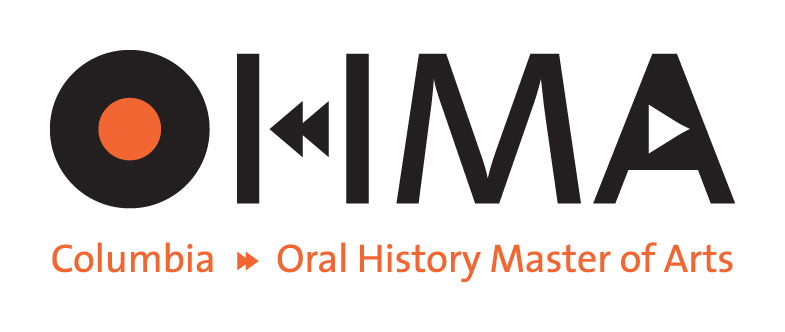In this post, Robin Weinberg (2016) shares her thoughts about oral history after a presentation by DW Gibson, author of The Edge Becomes the Center: An Oral History of Gentrification in the Twenty-First Century, in OHMA’s 2016-2017 Oral History Workshop Series.
It’s 9:00 p.m. and I’m on a crowded train back to Connecticut. All the seats are taken except for a few geographically undesirable ones in the middle of the benches. You know, the ones where the occupants of the outside seats tacitly conspire to keep the middle seat empty by blockading it with bags and briefcases, and avoiding eye contact with every commuter shuffling down the aisle.
I shuffle by one such row. “Hello,” I say, forcing eye contact. “I’d like to sit there.” Cue the sighs, grunts, and exaggerated give-me-a-minute-while-I-move-this-bag-thank-you-for-the-inconvenience motions.
While my seatmates crack open their beers, I crack open my laptop and settle in for some thinking about the workshop I just attended. DW Gibson is a journalist, filmmaker, podcaster, and most recently the author of The Edge Becomes the Center: An Oral History of Gentrification in the Twenty-First Century. This is what he came to talk to us about.
Gibson’s book tells its story through the eyes of stakeholders along the entire spectrum: agents, buyers, sellers, landlords, tenants, politicians and contractors. At its essence, his book is about space—specifically in New York City—about people who inhabit that space and what happens when newcomers arrive and change the thing it is. We call this gentrification, but as Gibson says, that word has become diluted through overuse.
I’m wondering the same thing about the term “oral history.”
Let’s face it: the term is everywhere—Gibson’s book, magazines, tons of media, and entertainment websites. There are oral histories of “Wet, Hot, American Summer,” and “Breaking Bad.” There are interview-based oral history projects like Humans of New York and, of course, StoryCorps. I add my nonprofit, Just So You Know (an “oral history” project for people living with cancer) to this list.
My question is what makes something Capital O-Capital H “Oral History”? Can it, like everything listed above, differ in method and fieldwork from what we are learning in . . . well . . . OHMA’s Method, Fieldwork, and Interpretation course? Is it Oral History only if it has an important larger goal?
I enrolled in OHMA to grapple with these questions.
My nonprofit gives cancer patients the chance to record their life stories through conversations with their family and friends. The recordings are for them to keep—not for another research purpose. Humans of New York interviews people on city streets and publishes stories on social media and in books. StoryCorps entertains millions of people through its radio shows, website and publications. Let’s call these small o-small h “oral histories.”
What about those projects that do so much more? Look at Dan Kerr and his work with the homeless. He used the interviews he collected to start an activist movement by and for the homeless, which resulted in real change. Look at Alessandro Portelli, whose oral histories give otherwise unattainable depth to historical analyses of important events. These are surely Capital O-Capital H Oral Histories.
I believe DW Gibson’s book falls towards the capital letter end of the spectrum. He thinks critically about the intersubjective nature of the oral history exchange, and uses interview practices familiar to oral historians: long interviews, deep listening, dialogic exchange. He uses life histories to make sense of present-day experience.
But, at least for now, it doesn’t have a Kerr- or Portelli-like goal of producing historical sources, shifting historical narratives, or directly making social change. The interviews are not archived, transcribed, or made available to the public or researchers, and there aren’t activist programs designed around it.
Gibson wrote his book to present all sides of the issue (he is a journalist, after all), to provoke conversation, and be interesting to read. As Gibson stated, this last point is the most important, otherwise no one will buy the book. While he didn’t say if he has a larger goal, maybe he’s thinking it’s now up to his readers to start community conversations, identify areas for change, and find ways to reclaim and save their space.
I think about my nonprofit, too, through this Kerr-like lens. Maybe I can work with cancer patients to identify their common concerns, or give them the space to have these conversations. And then move my small o-small h project to the capital letter end of the spectrum.
There’s a lot of emphasis in oral history on space—space to talk, interpret, and interact with other people. For Gibson, it’s also the physical locations. For me right now, space is this middle seat I fought for, where I get to think about all these things.
The train pulls into my station. I shut my computer and hoist myself over my neighbor. Hopefully tomorrow, I’ll get to think about all this from a window seat.
Robin Weinberg is currently an OHMA student and founder of Just So You Know, a 501(c)(3) nonprofit organization that helps people living with cancer record their life stories through conversations and interviews with their family, friends, and favorite people. Watch some of the videos at www.just-so-you-know.org.
P.B. (post-blog): My very brilliant classmates and I talk a lot about what oral history is and what can be done with it. I like the idea of this scale, but I’ve come to believe that being on the capital O-H end does not makes a project more “worthy” or “important.”
Moreover, I’m not sure that that is even the goal to which we should all always aspire. I think, like history, conversations and interviews, oral history can be interpreted—and projects can be designed and used—an infinite different ways. And, I think as long as they are done responsibly and ethically, they all count.

